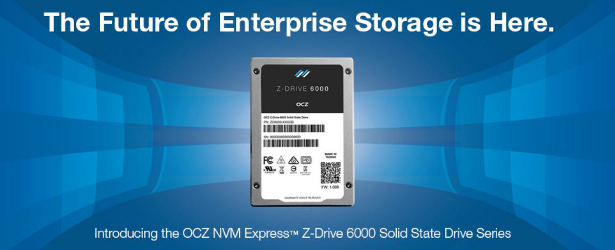Toshiba America Electronic Components, Inc. is announcing immediate availability of dual-port functionality on their award-winning OCZ Z-Drive 6000 NVM Express™ (NVMe) Solid State Drive (SSD) series. By adding dual-port connectivity to the Z-Drive 6000, two host systems are able to concurrently access data from the same storage device. This can also provide a redundant access path to the drive, which provides SAS-like features such as High Availability (HA) that designers of storage systems have come to rely on.
 With dual-porting, the Z-Drive 6000 series becomes a complete solid-state storage solution that meets the real-time I/O requirements of critical enterprise applications and virtual infrastructures. These storage architectures require low latency performance and high bandwidth, as well as redundancy.
With dual-porting, the Z-Drive 6000 series becomes a complete solid-state storage solution that meets the real-time I/O requirements of critical enterprise applications and virtual infrastructures. These storage architectures require low latency performance and high bandwidth, as well as redundancy.
 Dual port connectivity enables redundant data access, which eliminates a single point of failure when two hosts are accessing the same drive, and maintains Quality of Service (QoS) in the event one of the data paths becomes compromised in some way. This latest firmware update also provides some additional feature enhancements for the Z-Drive 6000 series, including multiple name spaces, non-binary sector sizes, self-encrypting drive (SED) and Crypto Erase.
Dual port connectivity enables redundant data access, which eliminates a single point of failure when two hosts are accessing the same drive, and maintains Quality of Service (QoS) in the event one of the data paths becomes compromised in some way. This latest firmware update also provides some additional feature enhancements for the Z-Drive 6000 series, including multiple name spaces, non-binary sector sizes, self-encrypting drive (SED) and Crypto Erase.
 According to Daryl Lang, Vice President of SSD Product Enablement for Toshiba America Electronic Components, “OCZ is excited to offer our customers this robust new firmware that enables the Z-Drive 6000 series to be a compelling solution, not only for low latency, high performance compute applications, but now also for storage-class applications where the additional enterprise class features are required to complement latency and performance.”
According to Daryl Lang, Vice President of SSD Product Enablement for Toshiba America Electronic Components, “OCZ is excited to offer our customers this robust new firmware that enables the Z-Drive 6000 series to be a compelling solution, not only for low latency, high performance compute applications, but now also for storage-class applications where the additional enterprise class features are required to complement latency and performance.”
 OCZ’s Z-Drive 6000 series is a consistently high-performing NVMe SSD with sustained 4K random read performance of over 700,000 IOPS, consistent low latency of 30 µs, and selectable power envelopes. The U.2-based Z-Drive 6000 SSDs are also hot-swappable, unlike traditional add-in cards of the past. The Z-Drive SSD series are designed for a wide range of storage architectures, with capacities ranging from 800GB to 6.4TB, and are available in both mixed workload and read-intensive versions.
OCZ’s Z-Drive 6000 series is a consistently high-performing NVMe SSD with sustained 4K random read performance of over 700,000 IOPS, consistent low latency of 30 µs, and selectable power envelopes. The U.2-based Z-Drive 6000 SSDs are also hot-swappable, unlike traditional add-in cards of the past. The Z-Drive SSD series are designed for a wide range of storage architectures, with capacities ranging from 800GB to 6.4TB, and are available in both mixed workload and read-intensive versions.
 Customers who have already deployed final hardware and firmware Z-Drive 6000 SSDs who wish to upgrade to dual-port firmware should contact OCZ Product Management for assistance. You can view The OCZ Z-Drive 6000 series product page here.
Customers who have already deployed final hardware and firmware Z-Drive 6000 SSDs who wish to upgrade to dual-port firmware should contact OCZ Product Management for assistance. You can view The OCZ Z-Drive 6000 series product page here.
 The SSD Review The Worlds Dedicated SSD Education and Review Resource |
The SSD Review The Worlds Dedicated SSD Education and Review Resource | 
I’m curious as to how you would wire this up between 2 host systems. What external interface supports NVMe?